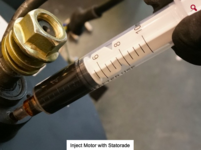RickBradford
Member
- Region
- Asia
This is a bit of a long story about motor types, and effectiveness. I evaluate my e-bikes for effectiveness by their combination of speed, range, and rider power input which are optimal.
For 2 years I rode a 500W 36V front-hub motor from a Chinese company called Jueshuai, which features 3 modes - Eco, Trail and Boost - which put out approximately 125W, 250W and 500W respectively. The cadence sensor is on-off and the electronics is square wave - turn the pedals at any cadence and you get the full power of whatever mode you are in.
This makes calculating power output very easy. In Trail mode, my preferred mode, the motor is constantly pushing out 250W, and with the 360Wh battery I have installed, that gives me about 80 minutes of continual riding. The distance I travel depends on the speed I go at, which in turn is directly related to how much extra power I apply.
I have recently switched to a 500W 36V mid-drive Tongsheng motor with torque sensing which has 4 modes - Eco, Tour, Sport and Turbo, although I still cannot get an accurate view of how much assist each mode gives - 50% or 100%, that sort of thing. I can guess at the amount of power being consumed by looking at the battery voltage before and after and using a crude discharge vs voltage graph. Or if I run out of power completely ....
I have compared the two motors (on the same frame) and my conclusion is that the front hub motor is considerably more efficient.
My standard commute is a 30km round trip on good asphalt, not flat, but not exceptionally hilly. Using the Jueshuai front hub motor in constant 250-watt Trail mode, I can maintain a speed of 28kph with moderate effort so that the round trip take about 65 minutes, well within my 80-minute limit. Using the Tongsheng, I decided to match the 28kph speed, and found myself working the pedals a lot harder and calculated that the motor was putting out an average of 305 Watts. More rider effort, more motor power, same speed. I've done other experiments, which show that to keep average motor output to 250 watts, I have to dial back the average speed to around 25.5kph on the Tongsheng motor.
Anecdotally, the Jueshuai front hub just eats medium inclines, and even on the steepest inclines outpaces the Tongsheng comfortably. It's an anti-gravity device. The Tongsheng, on the other hand, sends immediate signals when it hits even the slightest incline.
I've done enough riding on the Tongsheng to generally confirm this diagnosis - the Jueshuai front hub delivers more speed for more range for less rider input. But this goes against everything I read about mid-drive torque sensor motors, which one enthusiast described as "incredibly effective".
Anyway, that's my experience, apologies for the long post and I would welcome any insights from more experienced members.
For 2 years I rode a 500W 36V front-hub motor from a Chinese company called Jueshuai, which features 3 modes - Eco, Trail and Boost - which put out approximately 125W, 250W and 500W respectively. The cadence sensor is on-off and the electronics is square wave - turn the pedals at any cadence and you get the full power of whatever mode you are in.
This makes calculating power output very easy. In Trail mode, my preferred mode, the motor is constantly pushing out 250W, and with the 360Wh battery I have installed, that gives me about 80 minutes of continual riding. The distance I travel depends on the speed I go at, which in turn is directly related to how much extra power I apply.
I have recently switched to a 500W 36V mid-drive Tongsheng motor with torque sensing which has 4 modes - Eco, Tour, Sport and Turbo, although I still cannot get an accurate view of how much assist each mode gives - 50% or 100%, that sort of thing. I can guess at the amount of power being consumed by looking at the battery voltage before and after and using a crude discharge vs voltage graph. Or if I run out of power completely ....
I have compared the two motors (on the same frame) and my conclusion is that the front hub motor is considerably more efficient.
My standard commute is a 30km round trip on good asphalt, not flat, but not exceptionally hilly. Using the Jueshuai front hub motor in constant 250-watt Trail mode, I can maintain a speed of 28kph with moderate effort so that the round trip take about 65 minutes, well within my 80-minute limit. Using the Tongsheng, I decided to match the 28kph speed, and found myself working the pedals a lot harder and calculated that the motor was putting out an average of 305 Watts. More rider effort, more motor power, same speed. I've done other experiments, which show that to keep average motor output to 250 watts, I have to dial back the average speed to around 25.5kph on the Tongsheng motor.
Anecdotally, the Jueshuai front hub just eats medium inclines, and even on the steepest inclines outpaces the Tongsheng comfortably. It's an anti-gravity device. The Tongsheng, on the other hand, sends immediate signals when it hits even the slightest incline.
I've done enough riding on the Tongsheng to generally confirm this diagnosis - the Jueshuai front hub delivers more speed for more range for less rider input. But this goes against everything I read about mid-drive torque sensor motors, which one enthusiast described as "incredibly effective".
Anyway, that's my experience, apologies for the long post and I would welcome any insights from more experienced members.

